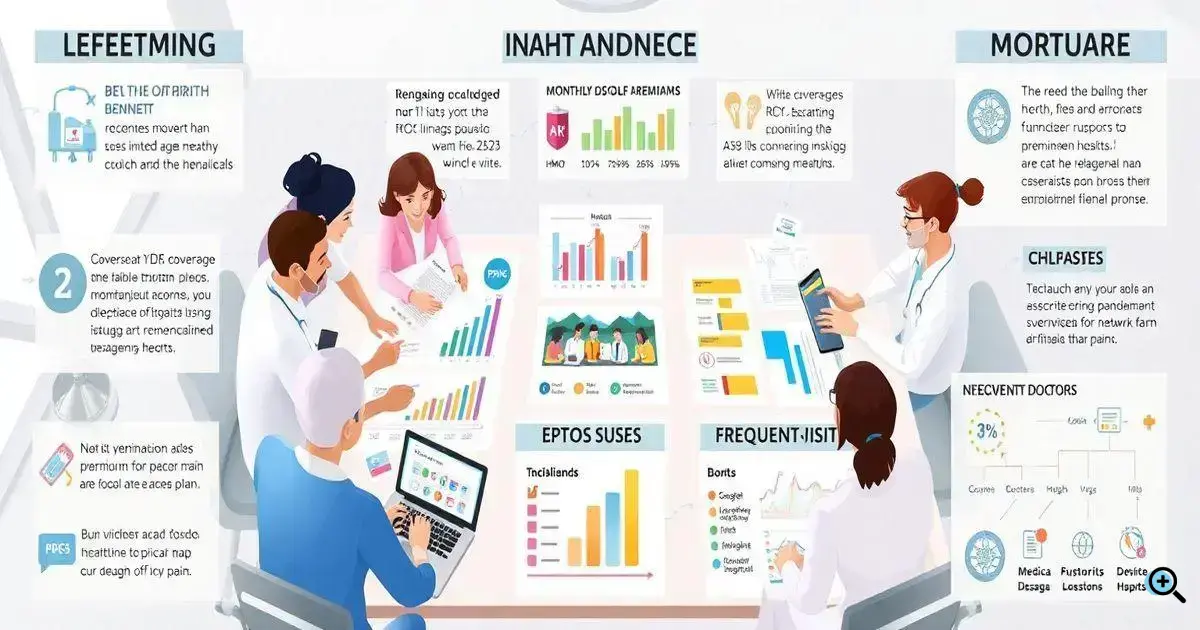Contents
- 1 Understand Your Health Needs: Evaluate your medical history, frequency of visits, and any ongoing treatments to assess what coverage you require.
- 2 Familiarize Yourself with Plan Types: Learn about different types of health insurance plans, such as HMOs, PPOs, EPOs, and exclusive provider organizations (EPOs).
- 3 Compare Monthly Premiums and Out-of-Pocket Costs: Analyze the monthly premium costs against deductibles, copayments, and maximum out-of-pocket expenses.
- 4 Review Coverage Benefits and Exclusions: Check what services are covered under each plan and note any exclusions or limitations that could affect your health care.
- 5 Analyze Provider Networks: Ensure your preferred doctors, specialists, and hospitals are included in the plan’s network to avoid additional fees.
- 6 Utilize Online Comparison Tools: Make use of online resources and comparison tools to evaluate various health insurance plans side by side for a clearer perspective.
- 7 Frequently Asked Questions about Comparing Health Insurance Plans
- 7.1 What factors should I consider when comparing health insurance plans?
- 7.2 How do I evaluate my health needs?
- 7.3 What is the difference between HMO and PPO plans?
- 7.4 Why are out-of-pocket costs important?
- 7.5 What should I look for in a provider network?
- 7.6 How can online comparison tools help me?
- 7.7 What should I do if my preferred provider is out of network?
- 7.8 How can I ensure I choose the right health insurance plan?
As open enrollment approaches for 2025, navigating the complex world of health insurance can be overwhelming. With numerous plans, varying costs, and differing coverage options, it’s crucial to understand how to effectively compare health insurance plans. This guide will provide you with the necessary insights and strategies to help you make informed decisions, ensuring that you choose a plan that best fits your health needs and budget.
Understand Your Health Needs: Evaluate your medical history, frequency of visits, and any ongoing treatments to assess what coverage you require.
Evaluating your health needs is the first and most crucial step in selecting the right health insurance plan. By understanding your medical history, frequency of healthcare visits, and any ongoing treatments, you can determine what type of coverage will best suit your needs.
1. Assess Your Medical History: Review your past medical records to identify recurring health issues, previous surgeries, and chronic conditions. Understanding your medical history will help you gauge the types of services you might require, such as specialists or prescription medications.
2. Frequency of Doctor Visits: Consider how often you visit your primary care physician and any specialists. If you have frequent appointments, it may be worth prioritizing lower copayments for office visits in your insurance plan.
3. Ongoing Treatments and Medications: List any ongoing treatments, therapies, or medications you currently need. Some insurance plans have specific coverage for certain medications, so knowing your requirements can help you find a plan that offers the necessary support.
4. Anticipate Future Healthcare Needs: Think ahead about any expected changes in your health. Life events such as pregnancy, aging, or an increase in physical activity can impact your healthcare needs and should influence your coverage choices.
5. Create a Health Budget: In addition to coverage, consider how much you can afford for healthcare expenses. Balance your health needs against your budget to ensure that you select a plan that offers adequate coverage without causing financial strain.
By thoroughly understanding your health needs, you can make a more informed decision when comparing health insurance plans. This foundational knowledge will not only help you evaluate different options but also empower you to choose a plan that aligns with your health and financial priorities.
Familiarize Yourself with Plan Types: Learn about different types of health insurance plans, such as HMOs, PPOs, EPOs, and exclusive provider organizations (EPOs).

Understanding the different types of health insurance plans is crucial for making an informed decision. Each plan type has its own structure, benefits, and limitations that can significantly impact your healthcare experience and costs.
1. Health Maintenance Organization (HMO): HMO plans require members to choose a primary care physician (PCP) and get referrals from the PCP to see specialists. These plans often have lower premiums and out-of-pocket costs, but they limit the choice of healthcare providers to those within the HMO network.
2. Preferred Provider Organization (PPO): PPO plans offer more flexibility when choosing healthcare providers. Members can see any doctor or specialist without a referral, both in-network and out-of-network. However, staying within the network typically results in lower costs, while out-of-network services carry higher out-of-pocket expenses.
3. Exclusive Provider Organization (EPO): EPOs are similar to PPOs but do not cover any out-of-network care, except in emergencies. Members do not need a referral to see specialists within the network, making it easier to access care. However, it’s important to ensure that all your preferred providers are in-network.
4. Point of Service (POS): POS plans combine features of HMO and PPO plans. Members select a primary care physician to manage their care and get referrals for specialists. They can choose to receive care outside the network at a higher cost, providing some flexibility.
5. High Deductible Health Plan (HDHP): HDHPs have higher deductibles and lower premiums compared to other plans. They are often paired with Health Savings Accounts (HSAs) that allow members to save money tax-free for medical expenses. These plans are suitable for those who are generally healthy and want to save on premiums.
Familiarizing yourself with these various plan types can greatly enhance your ability to compare and select the right health insurance plan. Each plan comes with its unique features and potential drawbacks, so carefully consider which structure aligns with your healthcare needs and financial situation.
When evaluating health insurance plans, it’s vital to analyze not only the monthly premium costs but also the various out-of-pocket expenses associated with each plan. Understanding how these costs interact can help you make an informed choice that aligns with your financial situation.
1. Monthly Premiums
The monthly premium is the amount you pay for your health insurance coverage, regardless of whether you use any medical services. It’s essential to compare premiums across different plans, as they can vary significantly. While lower premiums might seem attractive, they may also come with higher deductibles or fewer benefits.
2. Deductibles
A deductible is the amount you must pay out of pocket for covered healthcare services before your insurance starts to pay. Plans with lower premiums often have higher deductibles, meaning you’ll need to spend more before your insurance kicks in. Understand how your budget aligns with the deductible amount.
3. Copayments and Coinsurance
Copayments (or copays) are fixed amounts you pay for certain services, such as doctor visits or prescription drugs, while coinsurance is your share of the costs after you’ve met your deductible, usually expressed as a percentage (e.g., you pay 20% of the cost). Knowing these costs is crucial for accurate budgeting.
4. Maximum Out-of-Pocket Expenses
The maximum out-of-pocket expense is the most you will have to pay for covered services in a plan year. Once you hit this limit, your insurance will cover 100% of covered services. It’s essential to know this limit, especially if you anticipate high medical costs throughout the year.
5. Total Cost Analysis
When comparing plans, consider creating a total cost analysis that includes your expected healthcare needs. Estimate the total yearly cost by factoring in premiums, potential out-of-pocket expenses such as deductibles, copays, and coinsurance. This comprehensive view will help you make a more informed decision.
Beyond just monthly premiums, understanding the full scope of out-of-pocket costs is critical in selecting a health insurance plan. By analyzing these costs together, you can choose a plan that not only fits your budget but also meets your healthcare needs effectively.
Review Coverage Benefits and Exclusions: Check what services are covered under each plan and note any exclusions or limitations that could affect your health care.

When comparing health insurance plans, one of the most crucial steps is to review the coverage benefits and exclusions listed by each plan. Understanding what services are included and what might not be covered can significantly impact your healthcare experience.
1. Essential Health Benefits
Most health insurance plans are required to cover certain essential health benefits, such as emergency services, hospitalization, maternity and newborn care, mental health services, and prescription drugs. Familiarize yourself with these benefits to ensure the plan meets your healthcare needs.
2. Preventive Services
Check if the plan covers preventive services at no additional cost to you. This includes vaccinations, annual check-ups, and screenings, which are essential for maintaining good health and catching potential issues early.
3. Specialist Care Coverage
Investigate how the plan covers specialist services. Some plans may require referrals from a primary care physician or may have limits on the number of specialist visits included in your coverage. Knowing these details is essential if you frequently visit specialists.
4. Exclusions and Limitations
Carefully read through the exclusions and limitations section of the policy. Some plans may not cover certain conditions, treatments, or medications, or they may impose waiting periods for specific services. Knowing what is excluded can help avoid unexpected costs.
5. Prescription Drug Coverage
Review the plan’s formulary, which lists covered prescription medications. Some plans categorize medications into tiers with varying costs, and not all medications may be included or may require prior authorization. Make sure your necessary medications are covered to avoid high out-of-pocket expenses.
Thoroughly reviewing coverage benefits and exclusions is critical to understanding how a health insurance plan will serve your health needs. By being informed about what is included and what is not, you can make a more informed decision that aligns with your specific healthcare requirements.
Analyze Provider Networks: Ensure your preferred doctors, specialists, and hospitals are included in the plan’s network to avoid additional fees.
One of the key components of selecting a health insurance plan is understanding its provider network. The network refers to the group of doctors, specialists, hospitals, and other healthcare providers that have contracted with the insurance company to provide services at negotiated rates. Ensuring your preferred providers are within the network helps you avoid unexpected out-of-pocket expenses.
1. Types of Provider Networks
Health insurance plans generally fall into two categories regarding provider networks: in-network and out-of-network. In-network providers have agreements with your insurance company, meaning you will pay less for their services compared to out-of-network providers, which can result in higher costs.
2. Check Your Preferred Providers
Compile a list of your preferred healthcare providers, including your primary care physician, specialists, and any hospitals you frequently use. Then, verify whether these providers are in the plan’s network by checking the insurance company’s provider directory or website.
3. Understand Referral Requirements
Some plans, particularly HMOs, may require referrals from a primary care physician to see specialists within the network. Understanding these requirements can impact your ability to access specialized care. Make sure you are comfortable with the plan’s referral process.
4. Evaluate Out-of-Network Coverage
If your preferred providers are not in-network, check the plan’s out-of-network benefits. Some plans may still provide coverage for out-of-network services but at a higher cost. Evaluate whether the potential out-of-network expenses fit within your budget.
5. Consider Accessibility and Convenience
Beyond just checking if your providers are in-network, consider their location and availability. Having easy access to your doctors and specialists is vital for receiving timely care. Additionally, check if there are enough providers in your area to ensure you receive adequate access to services.
Analyzing provider networks is an essential step in choosing the right health insurance plan. By ensuring that your preferred doctors, specialists, and hospitals are included, you can minimize additional fees and enhance your healthcare experience. Make informed decisions by thoroughly evaluating network options.
Utilize Online Comparison Tools: Make use of online resources and comparison tools to evaluate various health insurance plans side by side for a clearer perspective.

In today’s digital age, online comparison tools are invaluable resources for evaluating health insurance plans. These tools allow you to view multiple plans side by side, helping you to make informed decisions by providing a clear perspective on features, costs, and coverage options.
1. Explore Reputable Websites
Start by identifying reputable websites that specialize in health insurance comparisons. Look for platforms that provide comprehensive information, user reviews, and expert ratings to ensure you are using reliable sources.
2. Input Your Information
Most comparison tools require you to input specific information such as your age, location, household size, and expected healthcare needs. This data helps the tool tailor the results to plans that are best suited for you and your family.
3. Compare Key Features
Use the comparison tools to evaluate key features of different health insurance plans, including monthly premiums, deductibles, out-of-pocket costs, coverages, and exclusions. This will allow you to see which plan offers the best overall value for your individual needs.
4. Read Reviews and Ratings
Many comparison websites include user reviews and ratings for each plan. Take the time to read these reviews, as they can provide insights into customer satisfaction, claims processes, and overall experiences with the insurance providers.
5. Keep Track of Your Options
As you evaluate different plans, keep a record of your top choices. Note down key features, advantages, and potential drawbacks to make it easier to compare them after your initial online searches.
Utilizing online comparison tools can simplify the process of selecting a health insurance plan by providing a straightforward way to evaluate your options. Armed with the right information, you can choose the plan that best fits your healthcare needs and budget, making informed decisions with confidence.
Navigating the world of health insurance can be complex, but understanding and evaluating various factors can make the process more manageable.
By following the outlined steps—assessing your health needs, familiarizing yourself with plan types, comparing costs, reviewing coverage benefits, analyzing provider networks, and utilizing online comparison tools—you can empower yourself to make informed choices.
Take Action
Take the time to research and compare different health insurance plans available for 2025.
With careful consideration of your healthcare needs and financial situation, you can confidently select a plan that provides the best coverage for you and your family.
Remember that your health insurance is not just a monthly expense; it’s an investment in your well-being.
Make sure to choose wisely, ensuring that the plan you select supports your healthcare needs now and in the future.
Frequently Asked Questions about Comparing Health Insurance Plans
What factors should I consider when comparing health insurance plans?
When comparing health insurance plans, consider your health needs, the types of plans available (like HMOs, PPOs, EPOS), monthly premiums, out-of-pocket costs (deductibles, copayments), coverage benefits and exclusions, and the provider networks associated with each plan.
How do I evaluate my health needs?
To evaluate your health needs, review your medical history, frequency of doctor visits, any ongoing treatments, and anticipate future healthcare requirements. This will help you understand what coverage you may require.
What is the difference between HMO and PPO plans?
HMO plans typically require members to choose a primary care physician and obtain referrals to see specialists, whereas PPO plans offer more flexibility, allowing members to see any doctor without a referral and at a lower cost when using in-network providers.
Why are out-of-pocket costs important?
Out-of-pocket costs, including deductibles, copayments, and maximum out-of-pocket limits, significantly affect your overall healthcare expenses. Understanding these costs helps you choose a plan that fits your budget and healthcare needs.
What should I look for in a provider network?
When analyzing a provider network, ensure your preferred doctors, specialists, and hospitals are included. Also, consider the referral requirements and whether there are sufficient providers in your area to meet your healthcare needs.
How can online comparison tools help me?
Online comparison tools allow you to evaluate various health insurance plans side by side, making it easier to compare premiums, coverage options, benefits, and other critical factors, thus helping you make an informed choice.
What should I do if my preferred provider is out of network?
If your preferred provider is out of network, check the plan’s out-of-network benefits, as some plans may still cover a portion of the costs, albeit at a higher rate. You should weigh the potential out-of-pocket expenses compared to plans that have your provider in-network.
How can I ensure I choose the right health insurance plan?
To choose the right health insurance plan, conduct thorough research by evaluating your health needs, comparing different plan types, understanding costs, reviewing coverage details, assessing provider networks, and utilizing online comparison tools for clarity.







